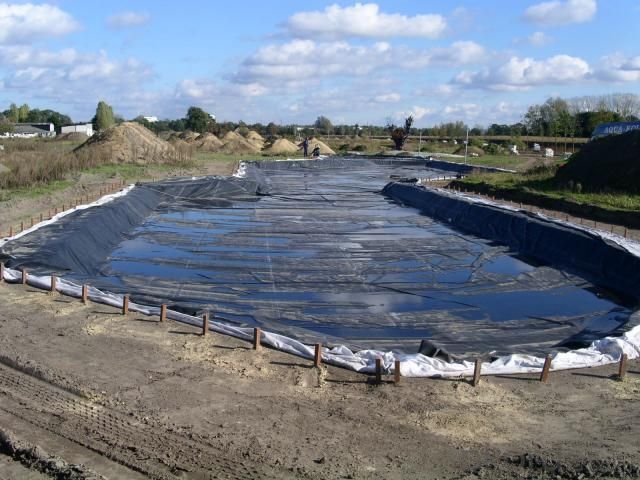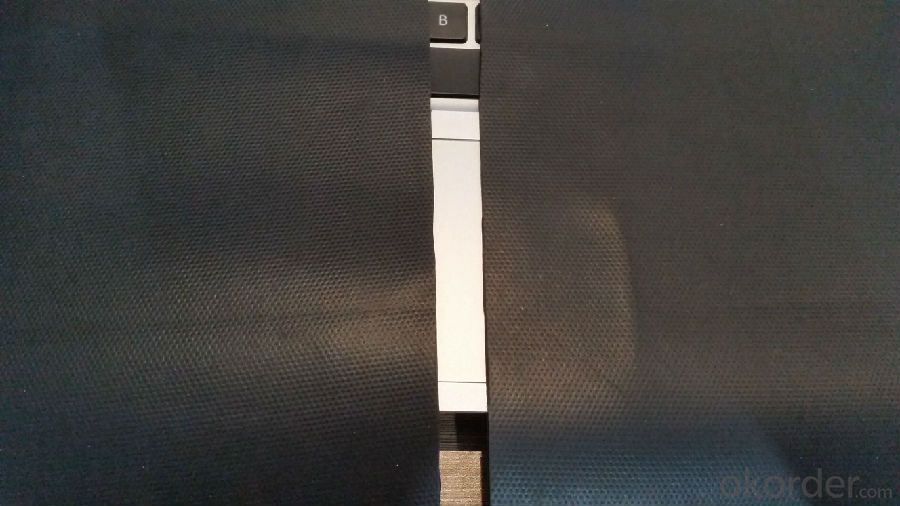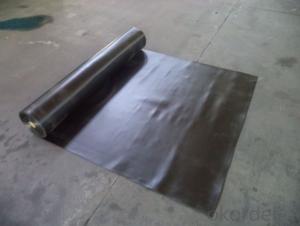EPDM Waterproof Vulcanized Membrane with 2.0mm Thickness
- Loading Port:
- Shanghai
- Payment Terms:
- TT or LC
- Min Order Qty:
- 20000 m²
- Supply Capability:
- 5000000 m²/month
OKorder Service Pledge
OKorder Financial Service
You Might Also Like
EPDM Waterproof Vulcanized Membrane with 2.0mm Thickness
Description Of EPDM Waterproof Vulcanized Membrane with 2.0mm Thickness:
1. EPDM waterproof membrane is made from ternary ethylene-propylene rubber, which is for waterproofing of exposed and non-exposed applications.
2. EPDM waterproof membrane production adopts the world-advanced equipment of cold feeding extrusion and continuous vulcanization technology.
3. EPDM waterproof membrane is of high elasticity among high polymer waterproof materials and becomes a world-popular waterproofing material.
Main Features of EPDM Waterproof Vulcanized Membrane with 2.0mm Thickness:
1.Excellent anti-aging performance, service life can reach 50 years;
2.High elongation, high tensile strength, heat treatment size change small;
3.Plant root penetration resistance is good
4.Good low temperature flexibility
5.Application is convenient, overlapping is firm and reliable, no environmental pollution;
6. Resistance to chemical corrosion, can be applied to special places;
7.Maintenance is convenient, the cost is low
Specifications of EPDM Waterproof Vulcanized Membrane with 2.0mm Thickness:
ITEM | STANDARO REQUEST | |
Tensile strength at breaking,normal temperature,Mpa | ≥7.5 | |
Elongation at breaking, % | ≥450 | |
Tearing strenght,KN/m | ≥25 | |
Bending at low temperature | ≤-40°C | |
Water impermeability,0.1Mpa×30min | Impermeability | |
Hot air aging 80°C×168h | Unchanging of tensile strength at breaking,% | ≥80 |
Unchanging of elongation at breaking,% | ≥70 | |
Appearance of 100% elongation | No crack | |
Property of anti alkali 10% Ca(OH)2×168h normal temperature | ≥80 | |
≥80 | ||
Applications of EPDM Waterproof Vulcanized Membrane with 2.0mm Thickness:
1.Roofs, Basement, Toilets
2. Industrial and civil building waterproofing
3. Geosynthetic liner for swimming pool, channels, irrigation system
4. Especially suitable for projects with high requirements in durability, anti-corrosion and deformation.



IMages of EPDM Waterproof Vulcanized Membrane with 2.0mm Thickness:




FAQ of EPDM EPDM Waterproof Vulcanized Membrane with 2.0mm Thickness:
1. What are we supplying?
We are specialized in producing Colorful Asphalt Roof Shingle, SBS/APP modified bitumen waterproof membrane, Self adhesive bitumen waterproof membrane, PVC waterproofing membrane, EPDM rubber roofing membrane, Single Component Polyurethane Waterproof Coating, and Spray Polyurea Waterproof Coating
.
2. How Many years experience do we have?
We have been exported to more than 20 countries in the past 15 years.
3. How long do we usually reply your request?
We always reply our customer within 24 hours.
- Q:Can a waterproofing membrane be used on adobe block surfaces?
- Yes, a waterproofing membrane can be used on adobe block surfaces. Adobe blocks are made from a mixture of clay, sand, and straw, which can be susceptible to water damage. Applying a waterproofing membrane can help prevent water penetration and protect the adobe blocks from moisture-related issues such as cracking, erosion, or mold growth. It is important to ensure that the waterproofing membrane is compatible with adobe surfaces and follows the manufacturer's guidelines for application. Additionally, proper surface preparation and repair of any existing damage is crucial before applying the membrane to ensure its effectiveness.
- Q:Does a waterproofing membrane have any impact on the thermal performance of a structure?
- The thermal performance of a structure can be influenced by a waterproofing membrane. Usage of a waterproofing membrane is common in buildings to prevent water infiltration, which can harm the structure over time. By creating a barrier against moisture, the membrane helps maintain the building envelope's integrity and safeguards against potential leaks or water damage. Regarding thermal performance, a waterproofing membrane can enhance insulation by reducing heat transfer through the building envelope. By preventing moisture from entering the structure, the membrane also prevents condensation formation, which can lead to mold growth and further damage to building materials. Moreover, certain waterproofing membranes are designed with additional insulation properties, such as foam or reflective coatings, which further improve a structure's thermal performance. These membranes decrease thermal bridging and enhance energy efficiency by minimizing heat loss or gain through the building envelope. It should be noted that the impact of a waterproofing membrane on a structure's thermal performance can vary depending on the specific type of membrane, its installation, and the overall building design. Consulting a professional architect or engineer is advisable to determine the most suitable waterproofing solution that meets both water resistance and thermal performance requirements for a particular structure.
- Q:Can a waterproofing membrane be used on metal surfaces?
- Yes, a waterproofing membrane can be used on metal surfaces. Waterproofing membranes are designed to protect surfaces from water penetration and can be applied to a variety of materials, including metal. These membranes are typically made of materials such as modified bitumen, EPDM, PVC, or TPO, which provide a durable and watertight barrier. Applying a waterproofing membrane to a metal surface can help prevent corrosion, rust, and water damage, making it a suitable solution for protecting metal structures, roofs, or surfaces that are exposed to moisture or water. However, it is important to ensure that the specific waterproofing membrane being used is compatible with the type of metal surface and that proper installation guidelines are followed for optimal performance and longevity.
- Q:Are waterproofing membranes suitable for wastewater treatment plants?
- Yes, waterproofing membranes are suitable for wastewater treatment plants. Wastewater treatment plants deal with the treatment and processing of wastewater, which contains a variety of chemicals, contaminants, and bacteria. These substances can be highly corrosive and can cause damage to the infrastructure of the plant if not properly protected. Waterproofing membranes provide an effective barrier against water and chemical penetration, preventing leaks, seepage, and corrosion. They can be applied to various areas of the plant, including tanks, basins, pipelines, and concrete structures. Additionally, waterproofing membranes are durable, long-lasting, and can withstand the harsh conditions and chemicals present in wastewater treatment plants. Therefore, using waterproofing membranes in wastewater treatment plants is a recommended practice to ensure the integrity, longevity, and efficiency of the infrastructure.
- Q:Sbs waterproofing membrane can make bathroom waterproof?
- And can be used in the basement, bridges, parking lots, swimming pools, tunnels and other buildings waterproof, moisture, steam, impermeable and various types of roof maintenance works, and the service life is very long, basically not bad,
- Q:Can a waterproofing membrane be used for warehouses or storage facilities?
- Warehouses or storage facilities can utilize a waterproofing membrane. These membranes are specifically designed to safeguard structures against water damage by creating a barrier that prevents moisture infiltration. In warehouses and storage facilities, there are often large areas that are vulnerable to potential leaks or seepage, such as roofs, walls, and floors. By installing a waterproofing membrane, these structures can be effectively shielded from water intrusion, thereby preventing harm to stored goods and maintaining the facility's integrity. Waterproofing membranes come in various types, including bituminous, liquid-applied, or sheet membranes, providing flexibility in selecting the most appropriate option based on the specific requirements of the warehouse or storage facility. Furthermore, waterproofing membranes offer additional advantages such as thermal insulation and resistance to chemicals, further enhancing their value in ensuring the durability and functionality of warehouses or storage facilities.
- Q:Can a waterproofing membrane be used on tunnels with water drainage systems?
- Yes, a waterproofing membrane can be used on tunnels with water drainage systems. A waterproofing membrane is designed to provide a protective barrier against water penetration and can effectively prevent water leakage into the tunnel. However, it is important to ensure that the waterproofing membrane is compatible with the specific water drainage system in place. The membrane should be installed in such a way that it does not obstruct or interfere with the functioning of the drainage system. Additionally, proper consideration should be given to the design and installation of the drainage system to ensure efficient water management and prevent any potential issues that could compromise the effectiveness of the waterproofing membrane. Overall, with proper planning and installation, a waterproofing membrane can be successfully used in tunnels with water drainage systems to ensure the overall integrity and longevity of the structure.
- Q:Can a waterproofing membrane be used for museums or art galleries?
- Yes, a waterproofing membrane can be used for museums or art galleries. Waterproofing membranes are commonly used in various industries, including construction, to protect buildings from water damage. In the case of museums or art galleries, where valuable artifacts or artwork are housed, it is crucial to maintain a controlled environment to prevent any water-related issues such as leaks, moisture, or humidity. A waterproofing membrane can be applied to the walls, floors, or even roofs of these establishments to create a barrier against water intrusion. It helps in preventing water from seeping through the building structure, protecting the artwork from potential damage. Additionally, a waterproofing membrane can also aid in controlling the humidity levels within the museum or art gallery. By reducing moisture penetration, it helps maintain a stable environment, crucial for preserving delicate artwork or artifacts that are sensitive to humidity fluctuations. Moreover, waterproofing membranes come in various types, allowing for customization based on the specific requirements of the museum or art gallery. Some membranes are designed to withstand high water pressure, making them suitable for areas prone to heavy rainfall or potential flooding. Ultimately, using a waterproofing membrane in museums or art galleries is an effective measure to safeguard the valuable contents of these establishments, preserving them for future generations to enjoy.
- Q:Can a waterproofing membrane be used in conjunction with insulation materials?
- Using both insulation materials and a waterproofing membrane together is often recommended in order to protect buildings from moisture and improve energy efficiency. The waterproofing membrane acts as a barrier against water infiltration, while the insulation materials help regulate temperature and minimize heat loss or gain. By combining these components, the building envelope can effectively shield against water damage and maintain a comfortable indoor environment. Proper installation and compatibility between the waterproofing membrane and insulation materials are crucial for achieving optimal performance and long-lasting results.
- Q:Can waterproofing membranes be used on plant rooms?
- Yes, waterproofing membranes can be used on plant rooms. Plant rooms often contain equipment and machinery that require protection from water damage. Waterproofing membranes provide a barrier against water infiltration, preventing leaks and potential damage to the plant room and its contents. These membranes are typically applied to the walls, floors, and roofs of the plant room to ensure complete waterproofing. Additionally, waterproofing membranes can also offer protection against other elements such as chemicals and temperature fluctuations, making them an ideal solution for plant rooms.
1. Manufacturer Overview |
|
|---|---|
| Location | |
| Year Established | |
| Annual Output Value | |
| Main Markets | |
| Company Certifications | |
2. Manufacturer Certificates |
|
|---|---|
| a) Certification Name | |
| Range | |
| Reference | |
| Validity Period | |
3. Manufacturer Capability |
|
|---|---|
| a)Trade Capacity | |
| Nearest Port | |
| Export Percentage | |
| No.of Employees in Trade Department | |
| Language Spoken: | |
| b)Factory Information | |
| Factory Size: | |
| No. of Production Lines | |
| Contract Manufacturing | |
| Product Price Range | |
Send your message to us
EPDM Waterproof Vulcanized Membrane with 2.0mm Thickness
- Loading Port:
- Shanghai
- Payment Terms:
- TT or LC
- Min Order Qty:
- 20000 m²
- Supply Capability:
- 5000000 m²/month
OKorder Service Pledge
OKorder Financial Service
Similar products
New products
Hot products
Related keywords





























